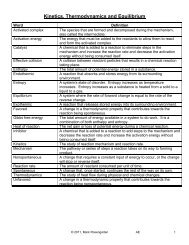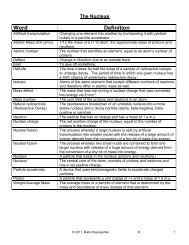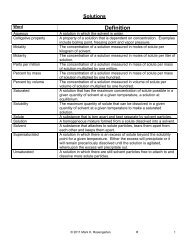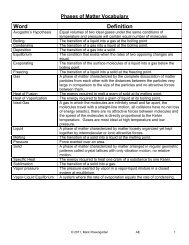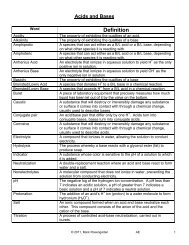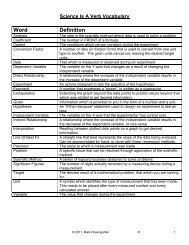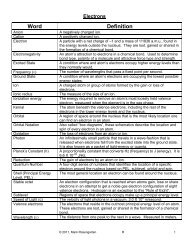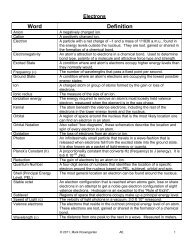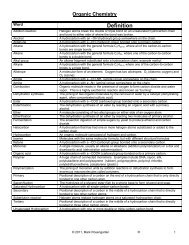Compounds - Mark Rosengarten
Compounds - Mark Rosengarten
Compounds - Mark Rosengarten
You also want an ePaper? Increase the reach of your titles
YUMPU automatically turns print PDFs into web optimized ePapers that Google loves.
Types of Chemical Formulas:<br />
1) Molecular Formula - indicates the total number of atoms of each element needed to form the molecule.<br />
MOLECULES ARE PARTICLES FORMED FROM THE COVALENT BONDING OF NONMETAL ATOMS.<br />
A molecule of methane contains one atom of carbon and four atoms of hydrogen, so the molecular formula is CH 4 .<br />
A molecule of benzene contains six atoms of carbon and six atoms of hydrogen, so the molecular formula is C 6 H 6 .<br />
2) Empirical Formulas<br />
represents the simplest ratio in which the atoms combine to form a compound. Empirical formulas are used to<br />
represent ionic compounds which form crystals of alternating + and – charge instead of separate molecules. CaCl 2<br />
is ionic, and the formula represents a ratio of 1 ion of Ca +2 to every 2 ions of Cl<br />
1 . If the crystal contains 3000 Ca +2 ions, then it will contain 6000 Cl<br />
1 ions. If the crystal contains one mole of Ca +2 ions, then it will contain two moles of Cl<br />
1 ions.<br />
All ionic compound formulas are empirical formulas. KCl has a 1:1 ratio, CaCl 2 has a 1:2 ratio and Al 2 (SO 4 ) 3 has<br />
a 2:3:12 ratio, none of which can be simplified any further.<br />
Molecular compounds like CH 4 (1:4), NO 2 (1:2) and H 2 O (2:1) cannot be simplified any further. For them, the<br />
molecular formula is also the empirical formula. Others can be simplified. C 6 H 6 (6:6) can be simplified to a 1:1 ratio,<br />
giving the empirical formula CH. H 2 O 2 (2:2) can be simplified to 1:1, for an empirical formula of HO. C 4 H 8 (4:8) can be<br />
simplified to a ratio of 1:2, giving the empirical formula of CH 2 .<br />
Gram Formula Mass (Molar Mass)<br />
STOICHIOMETRY - The study of quantitative relationships that can be derived from chemical formulas and equations.<br />
In working with chemical formulas, these involve ratios between the number of moles of atoms of different elements<br />
that comprise the compound.<br />
The mass of one mole of atoms of an element is equal to its atomic mass in grams. This is called the gram atomic<br />
mass of the element, and can be read directly off of the Periodic Table, rounding to the nearest tenth.<br />
The mass of one mole of molecules or formula units is equal to the sum of the gram atomic masses of the atoms that<br />
make up a mole of a particular molecule or formula unit. This number represents the gram formula mass, also called<br />
just formula mass.<br />
Determining the Gram Formula Mass of a Compound<br />
Here are the elements that are in the compounds in the examples of how to determine the gram formula mass. Let’s<br />
round each of their masses off to the nearest TENTH before doing the problems:<br />
39.1 40.1 27.0 14.0 16.0 35.5 32.1<br />
KCl: (1 K @39.1 g/mol each = 39.1 g/mole) + (1 Cl @ 35.5 g/mole each = 35.5 g/mole) = 74.6<br />
g/mol<br />
Ca(NO 3 ) 2 : (1 Ca @ 40.1 g/mol = 40.1 g/mol) + (2 N @ 14 g/mol = 28.0 g/mol) + (6 O @ 16.0<br />
g/mol = 96.0 g/mol) = 164.1 g/mol<br />
Al 2 (SO 4 ) 3 : (2 Al @ 27.0 g/mol = 54.0 g/mol) + (3 S @ 32.1 g/mol = 96.3 g/mol) + (12 O @ 16.0<br />
g/mol = 192.0 g/mol) = 342.3 g/mol<br />
© 2011, <strong>Mark</strong> <strong>Rosengarten</strong> AE 14



